Review GSM phone Motorola v635
Motorola
V635. Live pictures
Package:
- Handset
- Battery
- Charger
- Manual
- 16 MB (TransFlash) memory card and an SD format adapter for it
- Disk with software
- USB-cable for synchronization with PC
- Stereo headset
A popular triplet platform developed into a whole line of products similar both in parts and design. Frequently, the models differ in only one function, which makes them look similar in a customer's eyes. Motorola
v600 had been the top offer in a clamshell segment before the V3
RAZR appeared. Motorola
v620 was taken as a minimal renewal of the device providing a better phone book and 262K screen, but basically the phones were identical. This being said, a user of the Motorola v600 had no reason to replace the device with the new version and the v635 was produced especially for those people but also for those who thought that Motorola was lacking functions. A short list of the changes as compared with previous models is the following: TransFlash memory card, the appearance of a fully-functional mp3 player, EDGE, external color screen, more memory and a 1.23 MP camera with a flash. All these functions were put into the same Motorola v600 design with only a different front panel. There is a glossy plastic insertion on it. A loudspeaker placed on the bottom has metal netting clearly seen. The dimensions remained almost the same (89x49x25 mm), the device is more for men, though many women use the v600 and do not find it large.


The upper part of the phone got thicker due to a mega pixel camera integrated, all the dimensions increased about a couple millimeters (to compare - Motorola v600 has the dimensions of 88x47x23 mm). A fight for weight decrease ended in a slight decrease of the thickness of the aluminum panel closing the battery compartment. Subjectively, the cover is slightly thinner, which has not changed its durability.

It weighs 133 grams, which is considerably heavier than the majority of its rivals (the alternatives weigh100 grams or less). The explanation is the use of changeable metal panels on the front and back of the device. It is a true metal that even allows engraving, given the thickness. Considering the dimensions, this can be considered a good men's phone that is durable and heavy.

There is a volume button on the left-side surface and a Smart button, that differs in its functionality depending on the menu you are in, a bit lower (the OK function is normally assigned to it). The right-side button controls voice functions, the button may activate voice dialing or recording (both during a call and in the standby mode) if pressed and held.

The external screen is cSTN showing 4096 colours. The picture shown in the standby mode is dark but seen in bright conditions, which allows keeping the backlight off. The picture looks decent and the display is seen clearly with the backlight on indoors. The screen fades in the sun and makes it difficult to see, but that is typical of such displays. The resolution is 96x80 pixels (20x12 mm).
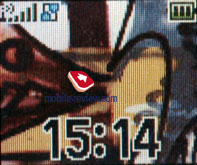

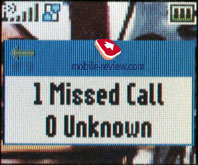
You can open the device with one hand. The internal screen shows about 262,000 colors with a resolution of 176x220 pixels (30x38 mm). Despite similar characteristics of Motorola
v535 and v620 and the same Sharp screen, we can see some improvement in the picture (hardly noticeable). It seems the images were not optimized to work with a richer palette and it happened here. There isn't a big difference between the screens in the triplets, the parameters vary little and a basic user won't notice that. The difference is seen only when comparing similar images on different phones but the difference disappears when working with interfaces. The v635's screen remains one of the best fitting the level of Sharp and Samsung. The TFT screen fades in the sun but the picture can be made out.



The keypad still takes a considerable part of the bottom part of the device. In addition to the two soft-keys and a navi button with the Ok one inscribed a button for fast call of the wap-browser and a camera button appeared. There was no room for them on the sides due to the existing design.

The keypad is lacquered plastic with grey number keys having some relief. The keypad is very comfortable to work with. A muted white backlighting is not even for all the keys and is seen in various conditions except for the bright sun.
A standard interface connector is placed on the bottom and a stereo headset connector is placed on the top. On removing the back cover you see a 780-mAh Li-Ion battery. According to the manufacturer it is capable of working for up to 80 hours in the standby mode and up to 3.5 hours in the talk mode. In Moscow the device worked for about 2 days with about an hour of calls and up to 30 minutes of using other functions. Shortening the talk time to 35 minutes and using other functions for only 20 minutes (with Bluetooth always on) increased the working time to 3 days. Average battery life is 2-3 days. Full recharging takes 2 hours. No extra capacity battery is provided.


Only a standard SIM-card connector is under the battery, no TransFlash slot, though many look for it here. The manufacturer implemented a semi-hot-swap slot for the memory card. You only need to take the upper cover off. The process resembles the one for Nokia phones, when the back cover is displaced and thus an access to the card in gained. This is an intermediate solution, not very comfortable and can't be treated as a fully-functional hot-swap. The memory card slot is equipped with a push out mechanism (it leaves the slot on press). The cards are nothing new, we have already seen them in Motorola
E398.

Menu
Differences from the previous models
Functionally, the model is a copy of Motorola
E398 with some software improvements distinguishing the device. First, RAM capacity grew and to 11 MB. This memory is mainly used by standard applications and you can't save maximum resolution photos on the phone memory, only on a card. What's strange is that it's in the menu and you only find out about the impossibility after a photo is taken. The memory is optimal for keeping melodies, applications, photos and data that shouldn't be saved on the card.
The interface of Motorola's phones has been developed gradually but not in discrete steps. Support for semi-transparent layers has become the next improvement in the software for developers. The only way to apply such a menu in the v635 was to use it in the camera interface, thus the pictured object is seen under the standard tips, the solution seems logical. The camera interface has been completely reworked. Now you don't need to call the menu to change this or that function, everything can be done with a navi button. Unfortunately, saving a photo still needs confirmation, which is basically pointless.
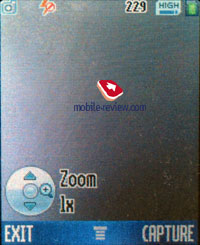
Two ways of text input may be adjusted here as a rule, iTap predictive input is first and then the Tap one providing letter by letter input. The language may be selected for each input type. The settings are flexible and allow you to adjust the phone, even alternating input languages. Your obedient servant has taken the fact that having adjusted the input in the phone book we get the same input order in other applications as a mistake. But that didn't happen, starting with the v635, personal order of input types and languages may be set for every function. By default, a standard order set by the manufacturer is provided for all the menus. With time you'll realize the whole pleasantness of the innovation. For instance, I keep all the contacts written in English and messages are typed in two languages gravitating towards Russian and correspondingly, having set Russian as a prior language for messages and English for the phone book, I really save time. Changing the menu language deletes all the settings applied.
Searching by full name should be mentioned as a necessary improvement. You can enter any line in any language. There are no more software changes as compared to Motorola E398 and Motorola v620 (one should have a closer look at the phone book, since there are negative but temporary changes).

Interface
You can access the Main Menu by pressing the Menu key (or an OK button), which is located under the screen right in the middle. The main menu is traditionally presented with 9 icons; each of them uses a service text line for definitions. You can switch the main menu's appearance to a list mode, and then everything will be presented with lists. Half of the menu is presented with lists and half with icons (if you use the appropriate menu look). The user can customize the order for the icons in the main menu (or the items in list view mode). The menu doesn't support fast number navigation, but you can setup shortcuts for almost every menu item or function. The navigational key can be assigned various actions to use in stand by mode. Moreover, you can adjust it in order to not have corresponding icons on the screen but they would appear with a press. Two soft-keys can be set to perform various actions as well, apart from the default ones. With such menu personalization flexibility the lack of the fast number navigation is not so noticeable.


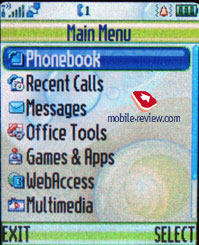
As we have already mentioned, the device supports iTap predictive text input. The current word is shown while input (in the lower service line) and variants of a word to select. When the dictionary is off, all the characters assigned to the button are shown. The device remembers the variants of the words you choose and after that offer them automatically. That helps to avoid entering words into the dictionary, as it is necessary in T9. That's curious other manufacturers will use the iTap technology in the near future, thus abandoning T9. The information is preliminary but has a high level of trustworthiness.
A pop-up menu allows choosing of two languages for writing text messages or letters. At the same time, input type is set from the beginning - letter-by-letter or predictive. That is rather a peculiar solution that allows getting flexible settings. I'd stress, the device is intended for mass audience judging by text selection, and not many people use more than two input languages.
Phone book. The phone book is of the old design here with no fields for entering a complete address in difference to younger models like Motorola v535, v620. The reason is in the developing time and the possibilities may be expected later with the renewal of the software. In a general list pressing a button calls the search menu and a search is done by any number of letters. Fast switch to a name by the number of the contact in the phone is traditionally provided.
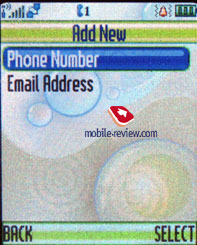
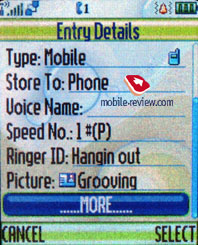
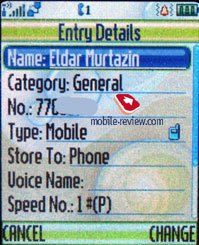
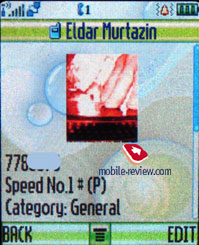
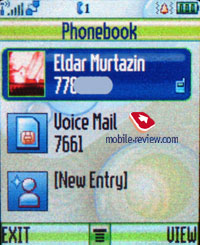
Up to 1000 entries can be stored in the phones memory, however only one number can be assigned to each. At the same time setting another order of entry representation in the phone book menu changes the phone book greatly. All the entries for a name are hidden behind the name in the general list. You are not limited in the number of fields and can keep several phone numbers and e-mail addresses. The matter is the representation you have chosen. The plus of the notion is you can select personal call and a picture that will be displayed during a call for each entry (for instance, one user but different numbers). In the general list each name with several numbers may be scrolled with horizontal presses, icons signifying the type of the number change. There are several user groups the entries may be distributed among.
However I have noticed a small disadvantage - when you are deleting an entry from the phone book, you will have to delete each number assigned to it separately. It's impossible to delete them at once.
You are free to choose the style of displaying entries in the phone book: either names with assigned images, or only names, you can also personalize the entry sorting style (quick dial number, name, e-mail address). Voice dialing can be setup as well and it works fine in various conditions.
The phone book is interesting in characteristics and nothing similar is offer by other manufacturers exist now, all of them have restrictions (one photo for a total name, no photo assigned to separate names, the same for personal melodies). At the same time, the phone book can't be called ideal in the absence of many fields and it needs investigating the structure.
Messages. The default memory capacity for 100 SMS is provided; it may also vary depending on the software version. As a rule, operator versions are limited by 40 messages. The device works with EMS. Automatic cleaning of the whole message list should be mentioned as an extra possibility; there is a list of templates. Delivery report may be on permanently or switched on/off for a message.
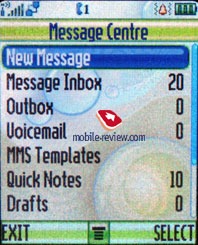
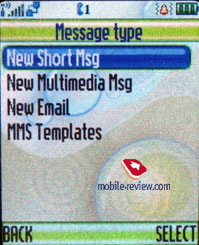
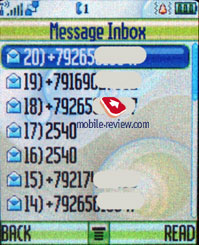
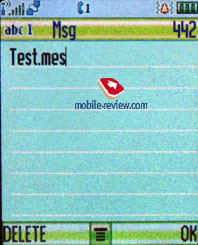

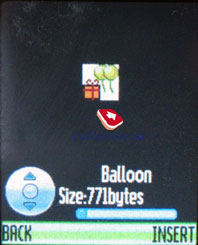
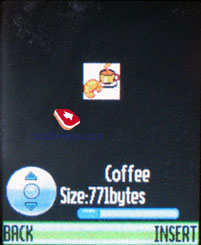
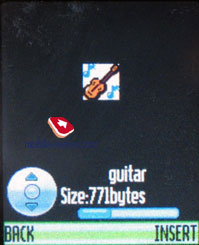
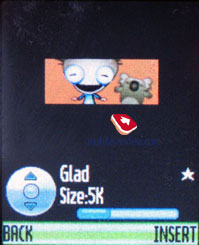
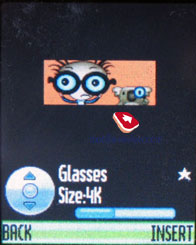
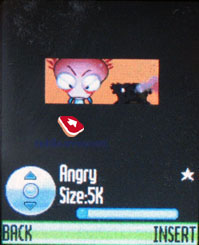
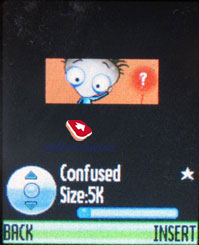
Working with MMS doesn't bring any inconvenience; everything is simple and easy to understand. The messages can be attached with pictures made by the built-in camera and/or sound files. The ten predefined templates are really great, be sure to check them out.



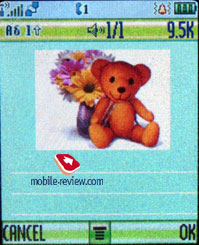
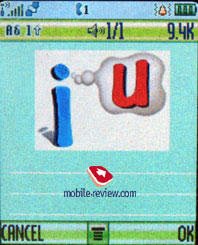
The phone has a POP3/IMAP4 e-mail client, which allows viewing the headers of the incoming mail and downloads their body as well. Only graphical files that do not exceed a certain size limit can be sent. In case you want to store some of the e-mails, you will have to use the dynamic spread memory, just like with MMS.
WAP. The phone has WAP-browser v2.0 and its possibilities are standard so nothing special can be said. GPRS (class 10) is present, the settings are rather simple, just follow your operator's instructions and everything will be done in a matter of minutes.

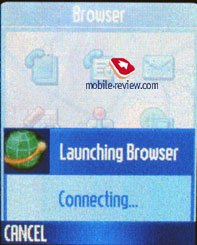
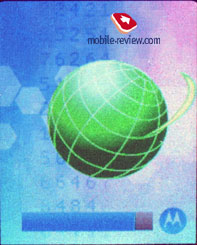
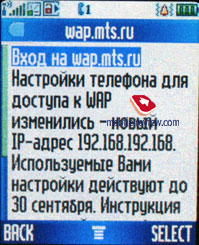
Records. The phone has a list of received calls; it includes the missed ones as well. You can also see the list of the 10 last dialed numbers; you can access it by pressing the Call button. Everything is rather simple and traditional, nothing special at all. Each entry features the date and time as well as the length.
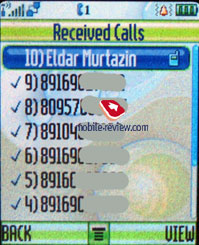
The phone life timer, calls of various types, connection time and data sessions are available from this menu.
Office applications. This menu features a whole bunch of office applications such as the Calculator. It's convenient, the full digital keyboard is present on the screen and it reproduces the real keyboard perfectly. The menu features memory options and a unit converter.

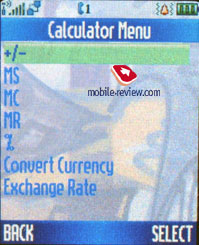
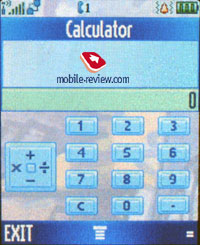
Shortcuts are located in the same menu. You can create shortcuts not only for various menu sections, but for a definite wap site as well.
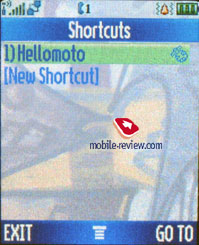
Alarm clock. You can create several alarm clocks and choose a custom ring tone, name and volume, type of reoccurrence (daily, single time) for each of them. This phone was designed for continuous, that's why entering names and titles for the alarm clocks is required. The alarm clocks are activated in one touch and tips ease working.
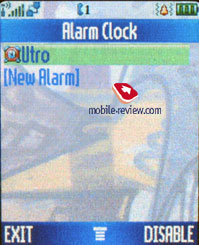
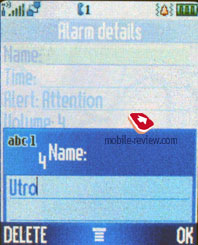
Dictaphone. You can create records from the stand by mode as well as during a call. The Dictaphone can record the whole dialogue. Maximum length for each entry is 60 seconds, however your caller will hear the sounds (at first it's zoommer, followed by short beeps with a continuous interval). There is no way to make it longer despite the dynamic memory present, only several records up to 60 seconds in duration (earlier the limit formed 120 seconds). The Dictaphone is weak, especially against the rivals recording up to an hour. In the listening mode, a percent of the total time but not reproduced time is shown, the discontinuity forms 5. That looks hardly comfortable since we all are used to representing record time and that seems logical.
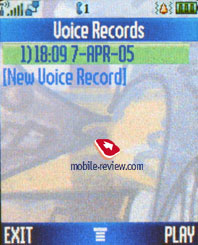
Organizer. You can view it monthly or weekly with a breakdown for hours. You will see your appointments set for a certain time of the day while viewing the calendar in the 2nd mode and it's convenient. Each entry can be assigned with a name, start time and length (measured in hours, the minimal amount of time - 30 minutes). A warning can be set in advance. Each entry can be recurrent, which is a big plus.
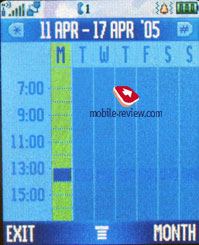
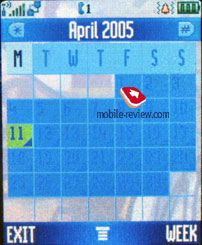
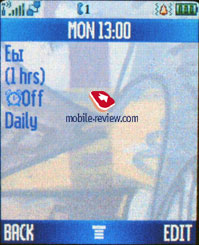
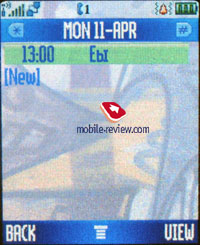
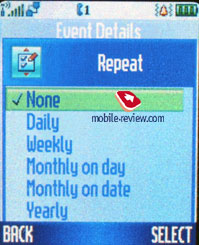
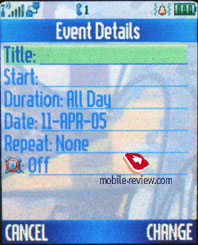
SyncML support is present, it's made for corporative users who are in great need of synchronization with data server (something similar to remote synchronization with Desktop PC, but this time the server must be located in the network).
Games and applications. The phone supports Java MIDP 2.0; all applications that are located in this menu are based on this technology. The number of games and their title depend on where the phone was bought. In the majority of cases you'll find such games as TopGun (arcade) and Golf.
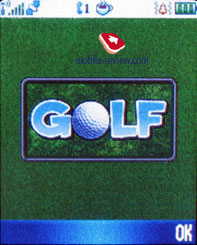
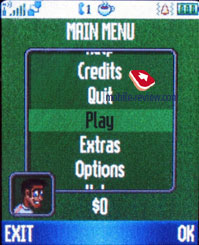
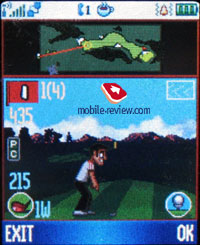

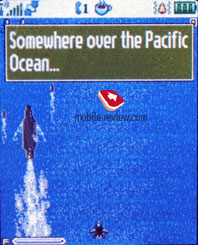

There is a well-known example of the Motorola E398 mp3 player written on Java in the games section. The player possibilities are wide (play lists, sorting, random track, repetition) but its realization as a separate application rouses questions. Launching the application will take time and you'll spend about a minute or more on it. On the one hand, it is not as much, but on the other hand, when such applications are integrated into the phone's software they are launched much faster (even on LG 1800). The impossibility to minimize the player and write an SMS or use another function is a big minus. Even no hint at multitasking, you can minimize the player and it will start working from the point it finished at. It will become a serious minus for many. The presence of a standard player with similar functionality makes a Java-application seem like a bonus.
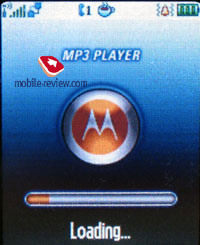
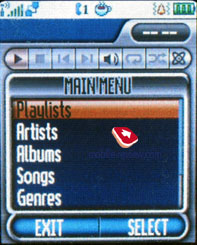
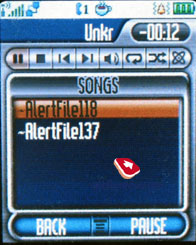

Multimedia. The phone supports themes. It's a set of wallpapers, color schemes for the menu, sounds and ring tone types. You can change the outlook of your phone almost instantly and this is really fun. New themes can be downloaded from Motorola's website.
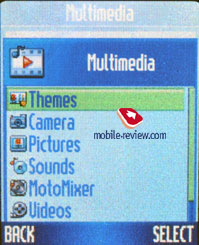

The skins haven't changed; there are three of them - standard, Techno and Neon. They change not only the color of the menu but also change the phone's interface.
MotoMixer - original sound file editor that allows mixing tracks. You can play with it from time to time; the results may come out rather unexpected and nice. However as the practice shows, these sound editors are nothing more than a toy for most users, only few of them take the tool seriously.

Sounds - information about all sound files located in the phone's memory is stored here. Finally, they may be listened to. The player is similar to other devices by the company and everything is plain and clear. Play lists are supported and that allows using the player instead of the Java mp3 player. The main advantage is the player can work in background mode.
Pictures - a list of all images located in the phone's memory. There's a special icon near the file name. Each picture can be set as the wallpaper or screensaver. Pictures can be sorted in categories; this will make the browsing easier. A special editor is present as well, it allows putting frames, changing color scheme and using special effects. The most convenient part is that after mocking the picture it can be stored with a new name. This means that both the original and the new picture will be available for use. This may come handy in case you want to edit the photo, and not get rid of the original.
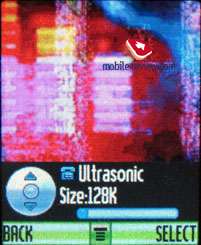
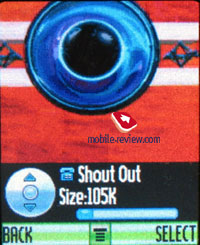
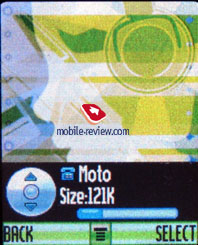
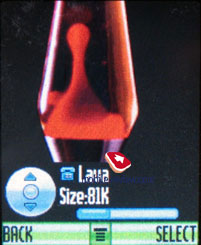
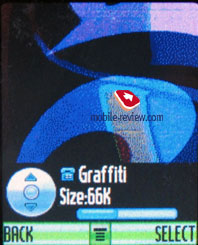
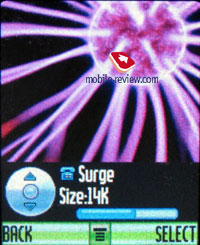
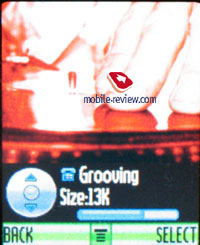
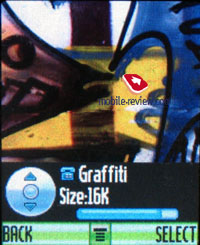
Settings. Here you can change all Display settings including the color schemes.
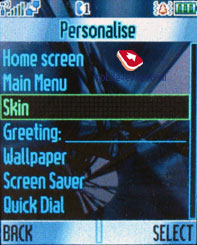
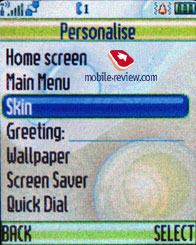
Ring tone type and notification mode (mixed mode, when the vibrating alert works at the same time with the ring tone is present) is here as well.
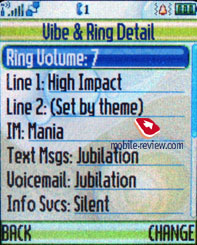
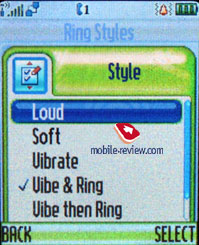
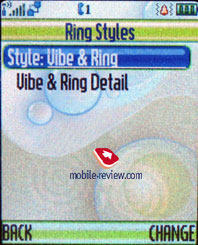
I don't think there is any need to describe the network and security settings since they're all similar to any other phone.
In the Connections menu you can switch the phone to work as a USB-drive and work with the memory card directly, which is useful. No drivers are necessary.
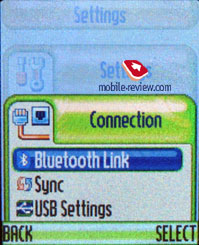
The Bluetooth settings remained the same and the device is still seen only for 60 seconds, which is not enough sometimes.
Camera. A 1.23 MP camera is integrated into the phone; it allows taking photos with the resolutions of 120x160, 240x320, 480x640 and 960x1280 pixels. The quality of saving images is the same and can't be changed from the menu. The possibility to switch off the shutter sound when shooting, set an exposure from -2 to +2, choose a lighting type (auto, sunny, cloudy, indoors, office) should be mentioned. There is a possibility to use a timer. The lighting source is activated from the menu and the camera may work even in the closed mode (self shooting is one of the variants then).


Maximum resolution photos may be saved only to the memory card and video is saved in the phone's memory. The quality of a CMOS-sensor is low, it gives up in bad lighting and photos are blurry and unclear. The best results are gained in the bright sun light and in other cases color saturation of the photo is not enough. Pleasantly, when working with the camera the picture is shown full-screen and tips are semi-transparent. Light settings may be changed with vertical presses of the navi button and it's also responsible for choosing effects (color, black and white, blue, old-like, red, green, negative). There is an 8x digital zoom.
Zoom function, outdoors, max resolution, ZIP-archive,
1.12 MB
Outdoors photos are of an average quality with nothing special. You can see it on our examples.
Sample
photo outdoors, ad on the wall, 960x1280 pixels, JPEG,
300 KB; Sony
Ericsson S700
Sample
photo outdoors, perambulator, 960x1280 pixels, JPEG, 260
KB; Sony
Ericsson S700
Sample
photo outdoors, garden, 960x1280 pixels, JPEG, 474 KB; Sony
Ericsson S700
Sample
photo outdoors, building, 960x1280 pixels, JPEG, 350 KB
Sample
photo outdoors, building in the sunset, 960x1280 pixels, JPEG, 172
KB
Sample
photo outdoors, Lyubanskaya square, 960x1280 pixels, JPEG, 185
KB
Sample
photo outdoors, Nautilys trade center, 960x1280 pixels, JPEG,
202 KB
Sample
photo outdoors, Nautilys trade center, 960x1280 pixels, JPEG,
189 KB
Sample
photo outdoors, the Kremlin, 960x1280 pixels, JPEG, 195 KB
Sample
photo outdoors, drugstore in the corner, 960x1280 pixels, JPEG, 270 KB
Sample
photo outdoors, flowers, 960x1280 pixels, JPEG, 243 KB
The quality of the picture lowers indoors.
Sample
photo indoors, flowers, 960x1280 pixels, JPEG, 283 KB;
Sony
Ericsson S700
Sample
photo indoors, flowers, 960x1280 pixels, JPEG, 274 KB
Sample
photo indoors, flowers with flash, 960x1280 pixels, JPEG,
187 KB
Sample
photo indoors, flowers with flash, 960x1280 pixels, JPEG,
251 KB
Sample
photo indoors, table with a monitor, flash, 960x1280 pixels,
JPEG, 212 KB
Sample
photo indoors, William Bass holder, 960x1280 pixels,
JPEG, 229 KB
Sample
photo indoors, glass with lemon, 960x1280 pixels, JPEG,
247 KB
Sample
photo indoors, mineral water, 960x1280 pixels, JPEG,
221 KB
When taking photos at night, you'll need to have firm arms otherwise they will get blurry.
Sample
photo at night, Lyubanskaya square, 960x1280 pixels, JPEG, 132 KB
The camera position makes you accidentally cover the objective with your hand from time to time, the finger lies on the phone projection and thus you get your finger on in the picture. Here is an example.
There are three quality kinds available for video - good, best, very best. The max duration is 60 seconds. What's curious is that the camera interface differs from the video recording one and that is another menu item. There is a fast settings change but the picture is shown on the part of the screen what is explained with the clip resolution (low - 128x96 pixels, high - 176x144 pixels). The quality of the video is average and sound may be turned off when recording.
Sample
video, best quality, 176x144 pixels, 3GPP, 483 KB
Sample
video, best quality, zoom, 176x144 pixels,
3GPP, 432 KB
Sample
video, best quality, exposition settings,
176x144 pixels, 3GPP, 472 KB
Productivity. Traditionally, the JBenchmark package was used for testing phone's productivity. The device showed no principal differences from the results the triplet platform provided. The production improvement is minimal and may be left out on account of this. In general, the model really looses to the majority of the models on the market in the Java-machine operating speed.
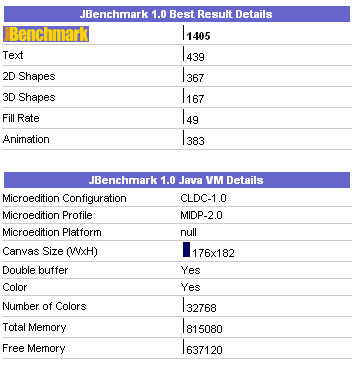
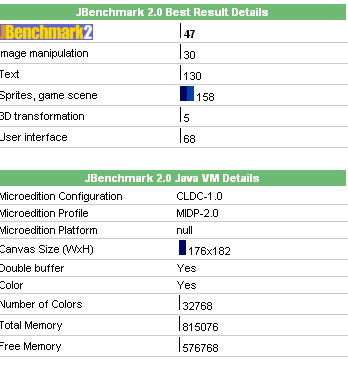
Synchronization with PC. A complete version of Mobile Phone Tools version 3 is included into the package. That is quite significant for the company, since lately even the Motorola V3 RAZR was provided with a cut version of MPT that prevented synchronization of the phonebook with MS Outlook, though a corresponding icon presented in the menu. The program possibilities cover the needs of the majority of users; they include synchronization with MS Outlook, making reserve copies on the PC, copying photos, melodies and writing messages on the PC.
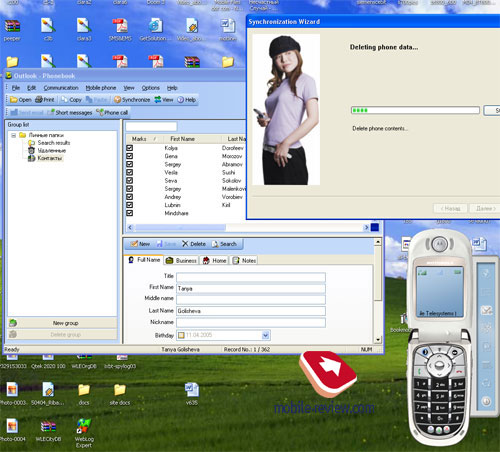
Impressions
The model has no problems with the connection quality being a typical modern device. The musical aspect is on the triplet's level, mp3 reproduction is present and limitations are not as strict. Signal volume is higher than average, Midi-files are played in the 24-tones polyphony that sound well also. The vibra is average or a bit more powerful. The loudspeaker volume is enough during a conversation almost always.
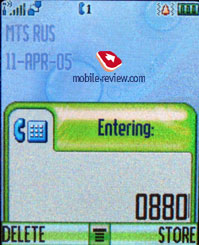
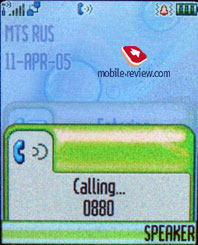
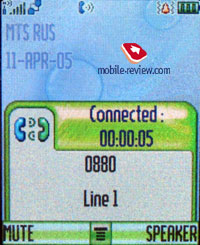

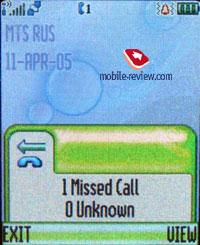
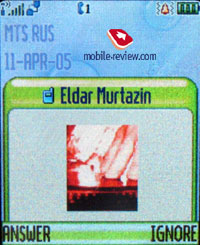
The localization is on the same level as for other models by the company, for instance, Motorola
E398. Functionally, the phone resembles the E398 but provides with another design, more memory and EDGE. By the way, the last function works well without any serious problems, the thing that upsets is there are no indicators on the screen (for example, in Samsung D500 an EDGE icon appears on the screen).
The presence of interchangeable memory cards allows using the phone as an mp3 player but its realization as a separate Java-application is not always comfortable and decreases the phone's comfort and one should use the normal player. The presence of a standard player connector and good earphones in the kit makes the device more interesting.
The camera is 1.23 MP, but judging by the quality of the photos, it is a typical middle class camera, the pictures are not bright and the colors are pale. It looks better on the PC screen but still far from ideal. The model looses in the camera quality to all of the models on the market being comparable only to Siemens products.
The interface improvements are insignificant since it has already been very well thought over, but still nice. The device is interesting and will suit those who need memory cards and used some of the Motorola's triplets. The Motorola v635 is mainly intended for men and won't suit women due to its dimensions. There is a disadvantage for those buying the device now, the card included in the package is 16 MB and starting from June a 32 MB one will be shipped with the phone. Anyway, in both cases you should buy a 128 MB card at once.
The fact that an accidental press of the browser button calls the browser closing even a running application is a slight disadvantage and the same can be said about the camera, which is uncomfortable sometimes. A slight shutter creak may be noticed on some phones and is caused by the rotation mechanism in the first models.
Today the device costs about 390-410 USD. That is rather high and is caused by the few that are available, as the market is not saturated with the model. The cost of about 350 USD may be considered acceptable and it will reach this level in the summer. Later the model has all the chances to become popular, since the company has always decreased the prices for its products dramatically. If an optimal price/quality ratio is kept, the model will remain popular at least till the second quarter of the next year.
Motorola v650 (a presumable name) with larger diagonal and higher resolution (like in the V3 RAZR) may be considered a replacement for the model, also Push to Talk will appear, outer antenna will disappear and the camera will become 1.3 MP. The main improvement will also concern the phone's dimensions, as it will get smaller. Such a model may be expected in October 2005.
Eldar Murtazin (eldar@mobile-review.com)
Translated by Maria Mitina (maria.mitina@mobile-review.com)
Published — 17 April 2005
Have something to add?! Write us... eldar@mobile-review.com
|
































































































